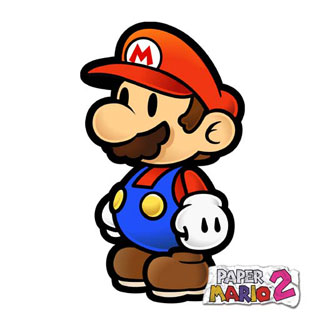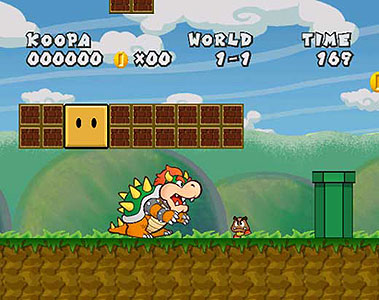"General White was the sad Ba-bomb that used to hang out in Petalburg. Speak to the Koopa Troopa in the very western section of Petalburg and he will remark that he thinks the General went to Keelhaul Key. On Keelhaul, speak to the Ba-bomb by the camp and he will tell Mario that the General has just headed for Glitzville. Go to Glitzville and talk to the bar tender at the juice bar and he will tell Mario that the Ba-bomb has gone to the Great Boggly tree. Speak to the Punnie at the entrance to the tree and he will tell Mario that the General has headed for Twilight Town. Speak to the guy in front of the inn and he will say the he's seen the General but that he has no idea where the bomb was headed."
- Dave Clayman, IGN Paper Mario: The Thousand Year Door Guide
"This is just filler. Ignore."
- Polly Esther
Roughly one year ago I took a slightly askew look at Alpha Dream's Mario & Luigi: Superstar Saga, the spiritual sucessor to Super Mario RPG published way back in the heyday of the Super Nintendo. Unbeknownst to me at the time, such a pseudo-sequel already existed just with a slightly different visual presentation: Paper Mario. And now there's a sequel to that sequel, entitled Paper Mario: The Thousand Year Door that sadly feels like Mario & Luigi: Superstar Saga with a slightly more amusing combat system but lacking a witty and gripping script. Oh, and about 200% more filler.
The Paper Mario series has a titular hook: the visual design is meant to represent Mario's world as consisting of, and constructed by, paper. Unfortunately it doesn't really look like paper but more along the lines of characters and objects rendered as 2D in a pseudo 3D world. Sure, the 'paper' theme is exploited decently in The Thousand Year Door but bits like being able to roll up into a ball aren't revolutionary in the least. Personally, when I think of paper I think of a ruled sheet with scrawlings and doodles in the margin, scotch tape on the corners and round perforations on the side. This isn't to say that The Thousand Year Door doesn't look good, because it's as sharp as a paper cut but Colorform Mario would be a far more appropriate title.

These colorforms inhabit a colorform world, one where the houses fold up when you enter them, where hidden sections of the city can be exposed by blowing on a wall's surface, where villains can literally chew the scenery. Intriguing, no? Tragically that's where the innovation and novelty wears off. The story is a plot stretched thinner than paper, featuring Mario attempting to rescue Princess Peach (why deviate??) from the X-Nauts (world-conquering evil-doers), and Bowser trying to one-up them all. The combat system, arguably the meat of the game, is a rehash of the same combat engine we've seen in all prior Mario RPG games: turn-based tomfoolery that requires simple reflex reactions to improve your standard defense and attack moves. The new twist to the system is a stage (literally, as you perform in a theater) where you perform your conflicts for an audience, an audience that rates how stylish your moves are and doles out star points (which can be used towards the traditional RPG ¨at;ber-attack) accordingly. Occasionally members of the audience can attack or aid your party, apparently according to their own sense of whimsy or boredom. Oh, and theater set pieces randomly fall on you. I said it was new, I didn't say it wasn't obnoxious.
"You start out at rank 20, and you’ll have to fight your way all the way up to rank 1 if you want to obtain the Crystal Star. This isn’t a simple matter of winning 20 fights in a row, though; each round will have certain conditions attached to it. For instance, one fight might require you to win in less than five rounds, while another might require you to Appeal to the crowd once or twice before dealing the finishing blow. The only way to increase your rank is to follow the guidelines, so be sure to note what they are before you enter the ring! They’re random, so you won’t get the same rules each time."
- Matthew Rorie, Gamespot Paper Mario: The Thousand Year Door Game Guide
One glimmer of intrigue in this new 'stage system' is the inclusion of the Hollywood star system to Mario's universe. Unfortunately it is almost completely useless in the game and feels like it was tacked on as a half-baked idea, but it essentially tags the stature of your character's popularity. In the beginning you're an unknown, halfway through the game you upgrade to being a B-List celebrity and then finally, near the end Mario makes the A-List and are rubbing shoulders with other such A-List Nintendo celebrities such as Samus and Link (off-screen and while your Gamecube is powered down, of course) and presumably, too popular to associate with the likes of you. It's an interesting spin on levelling, or would be if Fable and others actually hadn't beaten Paper Mario to the punch and executed it in a finer manner, as in one that actually has an effect on your game.

In between the many, many stage battles you'll inevitably encounter, you get to explore the limited landscape of each 'world' (all eight of them, in typical Mario style). You get to walk a lot. You have to tread, and retread the same land until you realize that yes, you're stuck in backtracking limbo. In fact, what time you don't spend in redundant stage battles will be spent traipsing back and forth along the same paths, sometimes in the most insidiously monotonous ways. The opening quote describing the search for General White is no joke, in fact it's by far one of the most ridiculous fetch quests I have ever encountered. You literally end up jaunting all over the entire Paper Mario world looking for this depressed loon, just to find him back where you started. It doesn't help that each area's environment and design feels forgettable. I often would end up roaming around in circles, clueless as to which direction I was heading in, whether I was roaming towards or away from whatever insipid goal I was assigned to. If I was lucky, I'd just end up falling asleep instead of circling the moebius strip of Rogue Island. Again, severely obnoxious.
"When you talk to Francesca, she tells you she can't see her father until she finds her wedding ring that Frankie lost. When Frankie says they should listen to the Don, Francesca gets mad and makes him say he loves her, 100 times. This isn't an idle threat; mash B to eventually get through the mountains of identical text screens, then keep going into the jungle to find the ring."
- Paper Mario: The Thousand Year Door GameFAQ authored by 'DarthMarth'
Yes, the developers literally require that you jam the B button 100 times before you can do anything else, apparently so you can fully experience Frankie's love for his honeymooning sweetie. When I encountered this lovely piece of vexation my patience completely gave out and I realized that The Thousand Year Door must be a giant cruel joke by its developers. This is when obnoxious crosses over into abhorrent, detestable, loathsome, mean and nasty. Stunts like this coupled with the endless backtracking, the pointless Princess Peach sub-missions and yes, even a semi-cute Bowser mini-game which has the koopa retreading levels from the original Super Mario Bros. appear to be no less than methods to distract us from the pretense of a worthwhile RPG. It is doubly sad that a game that falls in the shadow of Mario & Luigi: Superstar Saga can't even muster an iota of Superstar's savvy script, instead harboring lackluster dialogue references like "to the extreme", a horribly executed H.A.L. rip-off and simply childish banter such as "Thank ...HA! Thank NOTHING!!". The characters are bland, vapid stereotypes (with the exception of a quaint subplot involving a sea-faring ba-bomb) that do nothing to engage the player and the story shuffles and lurches along as if it were a car trying to accelerate in the wrong gear and with its parking brakes on.

The Thousand Year Door made me angry. I'm not going to deny it. And I'm not just upset because of the prior (and numerous) infractions, no definitely not. It made me angry because it feels lazy, languid and uninspired, its backtracking and seemingly arbitrary design decisions elicit the thought 'What the hell am I bothering with this for? This game is wasting my life.' This Paper Mario sequel ripped its visual style from its predecessor, and a ten year old combat system that lacks the depth to excuse the dearth of innovation. What also feeds the flames of my anger is the fact that, apparently, this laziness is applauded. This is not a game that deserves accolades, it deserves to be shunned for being nothing more than a shadow of its true potential. Trash the respawning, ditch the filler, let us have a quality ten hour experience instead of a frustrating and monotonous 25 hour one. Hire competent writers, hell get the authors of Superstar Saga on your team. At least Alpha Dream knew how to script a self-conscious, whipsmart story. Beef up the combat engine. Improve the spatial design of the lands. Know your characters inside and out, and realize how to convey that to your audience.
"Life is too short to play bad games."
- Tim Schafer
While I certainly agree with Mr. Schafer, I'll take a game that doesn't play exceptionally but brings something new to the table over The Thousand Year Door any day. An experimental dish that falters in some departments is much more fulfilling to my sensibilities than dressed up leftovers, especially when the plate is stuffed with tepid filler. While some critics have said that The Thousand Year Door is quality fodder for young ones and those largely unfamiliar with RPGs, I certainly wouldn't feed novice gamers this fluff and I doubt they'd have the patience for it. Each level is a chore to complete, every one elicits scoffs, disbelief and impatience with it's back-and-forth, capricious placement of quest-solving objects. While I wasn't the biggest fan of Mario & Luigi: Superstar Saga, it was by far more entertaining, creative and engrossing than The Thousand Year Door. Sequels should innovate, put a new twist on an old favorite instead of recycling the same game with gussied up visuals. Simply put, games like these are killing me, my spirit to continue gaming diminishes with each uninspired, grandly embraced game that makes it to my consoles. Games lacking creativity, passion and innovation are in my eyes simply not worth playing and Paper Mario: The Thousand Year Door fails all three litmus tests. While there's an absence of quality RPGs available at this moment, especially for the Gamecube, chewing on this sad sack of filler is worse than not gaming at all.




